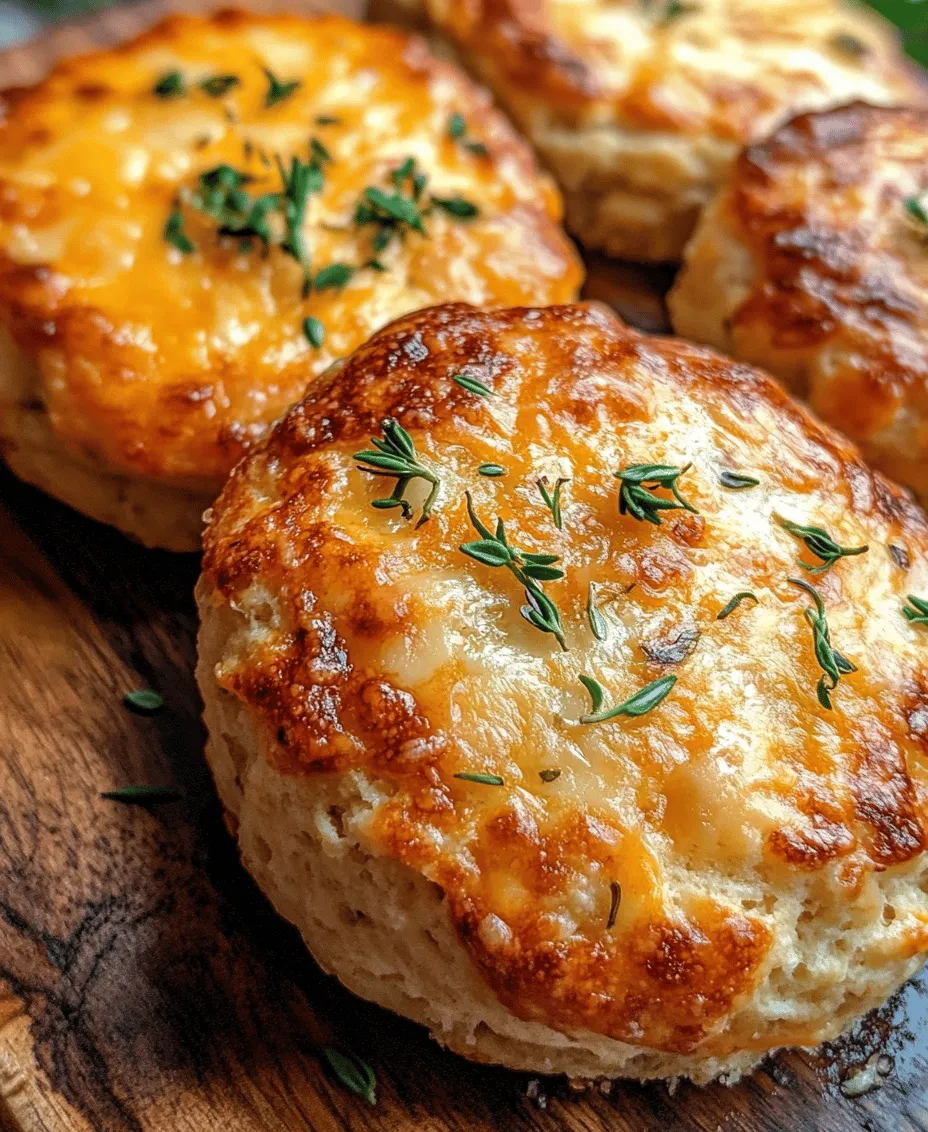Baking is an art that brings joy not only to the creator but also to those who indulge in the delicious outcomes. One of the most delightful creations in the baking world is the Savory Herb and Cheese Scone. These little bundles of flavor are a wonderful blend of buttery richness, fragrant herbs, and sharp cheese, making them a perfect addition to any brunch spread or tea time gathering. Whether enjoyed warm from the oven or as part of a picnic basket, these scones deliver a delightful crunch on the outside and a soft, tender crumb within.
The beauty of Savory Herb and Cheese Scones lies in their simplicity—quick to prepare and easy to bake, even novice bakers can achieve success. However, the flavor profile and texture of these scones reveal the depth of baking knowledge that can elevate a simple recipe into something extraordinary. In this article, we will walk you through the essential ingredients, their roles, and the step-by-step instructions that will guide you in creating these delightful scones.
Understanding the Ingredients
All-Purpose Flour: The Foundation of Your Scones
All-purpose flour serves as the backbone of any scone recipe. It provides the necessary structure for the scones while allowing them to rise beautifully in the oven. When selecting flour for your scones, it’s essential to consider the protein content. All-purpose flour typically has a moderate protein level, which balances tenderness and structure, making it ideal for scones.
For those looking to experiment with different textures, consider using a blend of all-purpose flour and whole wheat flour. This combination adds a nutty flavor and increases the fiber content, which can enhance the health aspect of your scones without compromising on taste.
Baking Powder: The Leavening Agent
Baking powder is the magical ingredient that ensures your scones rise to perfection. This leavening agent works by releasing carbon dioxide gas when it comes into contact with moisture and heat, creating those lovely air pockets that result in a light and fluffy texture.
It’s important to understand the difference between baking powder and baking soda. Baking soda requires an acidic ingredient to activate, while baking powder contains both the acid and the base, making it a convenient option for recipes that do not include additional acidic components. For savory scones, using baking powder is the most effective way to achieve the desired rise and texture.
The Flavor Profile of Herbs
One of the standout features of Savory Herb and Cheese Scones is the aromatic herbs that infuse them with flavor. Fresh herbs like rosemary and thyme not only enhance the taste but also add an enticing aroma to your baked goods.
Rosemary, with its pine-like fragrance, pairs beautifully with cheese, while thyme delivers a subtle earthiness that rounds out the flavor profile. Using fresh herbs over dried ones will yield a more vibrant flavor, making your scones even more delicious. If fresh herbs are not available, dried herbs can be used as a substitute; however, the flavor may not be as pronounced.
Cheese: Adding Richness
The choice of cheese is crucial in creating savory scones that are rich and flavorful. Sharp cheddar is a popular choice for this recipe due to its robust flavor that can stand up to the herbs. The melting properties of cheddar also contribute to the scone’s texture, creating pockets of gooey goodness that enhance the overall experience.
When selecting cheese, consider using a quality product that is aged for a more intense flavor. Other cheeses like Gruyère, feta, or even goat cheese can be used for variation, allowing you to customize your scones to match your taste preferences.
Cold Butter: The Secret to Flaky Scones
Achieving the perfect flaky texture in your scones hinges on the use of cold butter. When cold butter is incorporated into the flour, it creates small pockets of fat within the dough. As the scones bake, these pockets of fat melt, resulting in a light and flaky texture.
To properly incorporate cold butter, cut it into small cubes and add it to the flour mixture. Using a pastry cutter or your fingertips, quickly work the butter into the flour until the mixture resembles coarse crumbs. It’s crucial to handle the butter as little as possible to prevent it from melting, which could lead to dense scones instead of the desired light and fluffy results.
Buttermilk: Moisture and Flavor
Buttermilk is another key ingredient that contributes to the moisture and flavor of your scones. Its acidity not only helps to tenderize the dough but also enhances the overall flavor profile. The tangy taste of buttermilk complements the herbs and cheese beautifully, adding depth to the scone’s flavor.
For those who do not have buttermilk on hand, there are easy alternatives. You can make a quick substitute by mixing one cup of milk with a tablespoon of lemon juice or vinegar and letting it sit for about 5-10 minutes. This homemade version will mimic the acidity of buttermilk, allowing for similar results in your baking.
Step-by-Step Instructions for Savory Herb and Cheese Scones
Prepping the Oven and Baking Sheet
Before you dive into mixing your ingredients, take a moment to prepare your workspace. Preheating the oven is crucial for ensuring that your scones bake evenly and achieve the best rise. Set your oven temperature to 400°F (200°C) and allow it to preheat fully while you prepare the dough.
While the oven is heating up, line a baking sheet with parchment paper. Parchment paper not only prevents the scones from sticking but also aids in clean-up, making your baking experience more enjoyable. If you don’t have parchment paper, a well-greased baking sheet can also work, but parchment provides an additional layer of convenience.
Mixing the Dry Ingredients
Once your oven is preheated, it’s time to start mixing the dry ingredients. In a large mixing bowl, combine the all-purpose flour, baking powder, and a generous pinch of salt. Seasoning your dry mixture is essential, as it enhances the overall flavor of the scones.
It’s important to whisk the dry ingredients together thoroughly to ensure that the baking powder is evenly distributed. This step will help prevent any pockets of unactivated leavening agent, ensuring that your scones rise uniformly.
Incorporating Cold Butter
Now comes the moment to incorporate the cold butter into your dry mixture. As mentioned earlier, the technique you use is vital for achieving that coveted flaky texture. Take your cold butter cubes and add them to the flour mixture. Using a pastry cutter, fork, or your fingertips, start cutting the butter into the flour until the mixture resembles coarse crumbs with pea-sized pieces of butter.
Be mindful of the temperature; if your kitchen is warm, consider chilling your mixing bowl or working quickly to keep the butter from melting. The goal is to have visible flecks of butter throughout the mixture, which will create the perfect texture as the scones bake.
As we move forward, we will explore the remaining steps to complete your Savory Herb and Cheese Scones, diving into the incorporation of wet ingredients and the baking process. Stay tuned for the next part that will guide you through the finishing touches and baking tips that will help you achieve perfection with your scone-making journey.
Adding Cheese and Buttermilk
When it comes to achieving the perfect savory herb and cheese scone, the incorporation of cheese and buttermilk is crucial. These ingredients not only enhance the flavor but also contribute to the scone’s delightful texture.
Tips for Folding in Ingredients Gently
After preparing your dry ingredients, the next step is to fold in the cheese and buttermilk. Use a spatula or your hands to gently combine these ingredients with the flour mixture. The key is to avoid vigorous mixing—this can develop the gluten in the flour, leading to dense scones rather than the light and flaky texture we desire. Aim to fold the mixture until just combined; it’s perfectly fine if there are a few dry bits remaining. This gentle approach ensures that your scones will be tender and airy.
Avoiding Overmixing for the Best Texture
Overmixing is one of the most common pitfalls in scone-making. If you handle the dough too much, you risk creating tough scones. When you add the buttermilk, pour it in gradually while gently incorporating it into the flour mixture. The dough should be slightly sticky but manageable. Once combined, avoid the temptation to knead the dough; instead, let it rest for a few minutes before shaping. This resting time allows the flour to hydrate fully, leading to a better texture.
Shaping the Dough
Shaping the dough is where the fun begins! A well-shaped scone not only looks appealing but also bakes evenly.
Techniques for Patting and Cutting the Dough
Once your dough is ready, turn it out onto a lightly floured surface. Pat the dough into a rectangle or circle about 1-inch thick. The thickness is crucial; if it’s too thin, your scones will bake up dry. Use a sharp knife or a bench scraper to cut your dough into squares or triangles, depending on your preference. Make sure to cut straight down without twisting the knife to ensure even edges that rise beautifully in the oven.
Different Shapes You Can Create (Squares vs. Triangles)
Traditionally, scones are cut into triangles, but squares are just as delightful and can be easier for serving. Triangles offer a classic look, while squares provide uniformity, making them a hit at brunch gatherings. You can even use cookie cutters for fun shapes, especially if you’re making them for a special occasion. Whatever shape you choose, remember to space them adequately on your baking sheet to allow for expansion during baking.
Baking the Scones
Now that your scones are shaped, it’s time for the oven. Proper baking techniques will ensure that your scones turn out golden brown, flaky, and full of flavor.
Importance of Spacing on the Baking Sheet
When placing your scones on the baking sheet, ensure they are spaced about an inch apart. This spacing allows heat to circulate around each scone, promoting even baking. If they are too close together, they may steam instead of bake, resulting in a less desirable texture.
How to Achieve a Golden Finish with Egg Wash
For that beautiful golden crust, apply an egg wash before baking. Whisk together one egg with a tablespoon of milk or buttermilk and brush this mixture lightly over the tops of the scones. This step not only enhances the color but also helps any toppings, like extra cheese or herbs, to adhere to the surface. Bake your scones in a preheated oven at 400°F (200°C) for 15-20 minutes, or until they are puffed up and golden brown.
Serving Suggestions and Pairings
The versatility of savory herb and cheese scones makes them an ideal accompaniment to a variety of meals.
Enjoying Scones Fresh Out of the Oven
Freshly baked scones are best enjoyed warm. Serve them straight from the oven with a selection of spreads. A dollop of butter or a smear of cream cheese can enhance their flavor significantly. Consider offering a homemade herb butter or a tangy goat cheese spread for an added gourmet touch.
Suggestions for Spreads and Toppings
In addition to butter and cream cheese, you can explore savory spreads such as hummus, pesto, or even a light tapenade. For a twist, try pairing your scones with a spicy aioli or a rich cheddar cheese spread. The combinations are endless, allowing you to cater to various taste preferences.
Pairing Scones with Meals
Savory scones can elevate any meal and are particularly delightful when paired with soups and salads.
Perfect Accompaniments for Soups and Salads
These scones are wonderful served alongside a steaming bowl of soup, such as tomato basil or a hearty chowder. Their rich flavors complement the broth beautifully, providing a satisfying contrast. Pairing them with a fresh garden salad also works well; the scones can serve as a delightful addition to a picnic or light lunch.
Creative Ways to Use Leftover Scones
If you find yourself with leftover scones, don’t fret! They can be repurposed into a delicious bread pudding or transformed into savory croutons for salads. Simply cube them, toss them with olive oil and herbs, and bake until crispy. This creative use reduces waste while providing a new way to enjoy your savory creations.
The Versatility of Savory Scones
Savory herb and cheese scones are not just a one-note wonder; they can be customized to suit your palate.
Customizing Your Scone Recipe
Feel free to experiment with different herbs and cheeses. Try adding herbs like rosemary, thyme, or dill for varied flavors. You can also substitute different cheeses based on your preference—feta, blue cheese, or even pepper jack can create delightful variations. For added nutrition, consider folding in some finely chopped vegetables like spinach, sun-dried tomatoes, or bell peppers.
Incorporating Vegetables for Added Nutrition
Adding vegetables not only enhances the flavor but also boosts the nutritional value of your scones. Grated zucchini or carrots can introduce moisture and a hint of sweetness, while roasted red peppers add a touch of smokiness. Just be sure to squeeze out excess moisture from vegetables like zucchini to prevent the dough from becoming too wet.
Sweet vs. Savory: Exploring Different Scone Varieties
Scones are often associated with sweet flavors, but savory varieties hold their own charm.
Brief Overview of Sweet Scone Recipes
Sweet scone recipes typically feature ingredients like sugar, fruit, and chocolate. Flavors can range from classic blueberry to decadent chocolate chip. Sweet scones are perfect for breakfast or tea time, often served with clotted cream and jam.
How to Balance Flavors in Savory Versus Sweet Scones
The balance of flavors in savory scones differs from their sweet counterparts. While sweet scones lean on sugar and fruit for flavor, savory scones benefit from herbs, spices, and cheese. When crafting your savory scone, consider the saltiness of your cheese and the freshness of your herbs to achieve a harmonious flavor profile.
Storing and Reheating Scones
To maintain the freshness of your savory herb and cheese scones, proper storage is essential.
Best Practices for Storage
Store your cooled scones in an airtight container at room temperature for up to two days. If you need to keep them longer, consider refrigerating them, although this may slightly alter their texture. For maximum freshness, you can also freeze the scones. Wrap them tightly in plastic wrap and place them in a freezer-safe bag. They can last up to three months in the freezer.
The Impact of Refrigeration on Texture
Refrigeration can cause scones to dry out or become denser over time. If you choose to refrigerate, be sure to consume them within a day or two. Avoid storing them in the fridge for extended periods unless freezing, as the texture may suffer.
Reheating Scones
When it’s time to enjoy your leftover scones, reheating them correctly is crucial to retaining their original flakiness.
Methods for Reheating to Retain Their Flaky Texture
To reheat scones, preheat your oven to 350°F (175°C). Place the scones on a baking sheet and cover them with aluminum foil to prevent over-browning. Heat for about 10-15 minutes or until warmed through. This method helps to revive their flaky texture and warm them gently.
When to Avoid Reheating
Avoid reheating scones in the microwave, as this can make them tough and chewy. If you’re reheating freshly baked scones, it’s best to enjoy them warm straight out of the oven rather than storing them for later.
Conclusion
Savory herb and cheese scones are a delightful addition to any baker’s repertoire. With their rich flavors and delightful texture, they can elevate any meal or occasion. By understanding the ingredients and following the detailed steps outlined in this guide, you’ll be well-equipped to create these delicious scones in your own kitchen. Whether served warm with spreads, alongside a comforting soup, or as a versatile base for creative toppings, your scones are sure to impress family and friends alike. Enjoy the process, and relish the delightful aroma that will fill your home as you bake these scrumptious treats!



